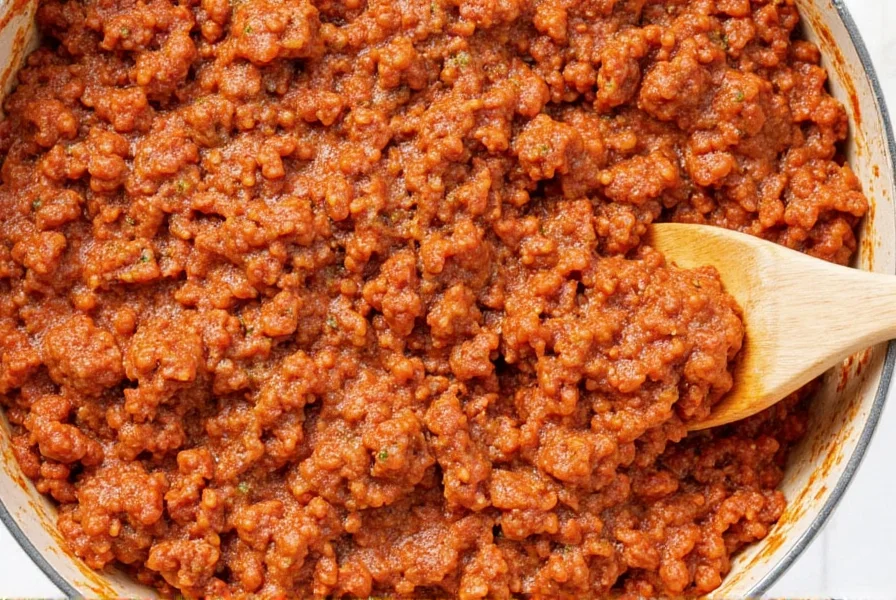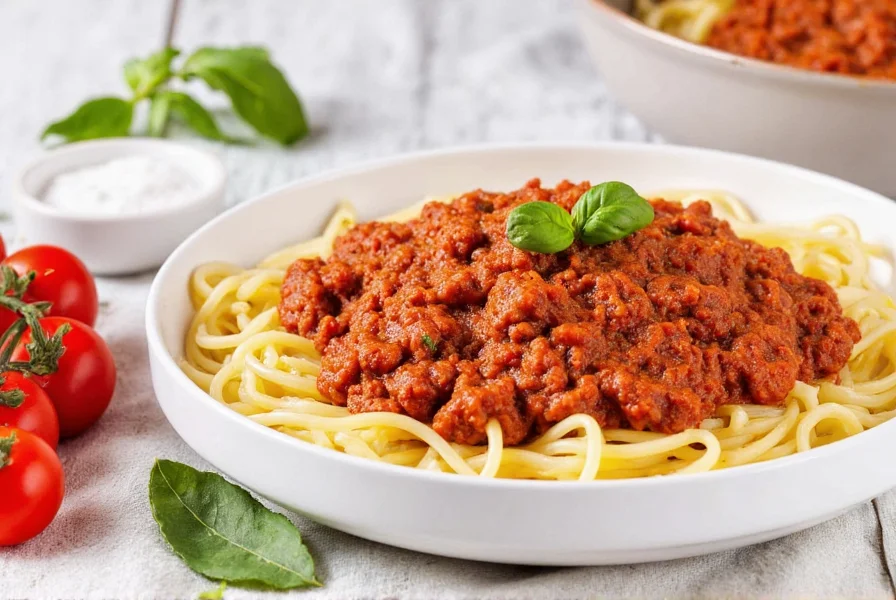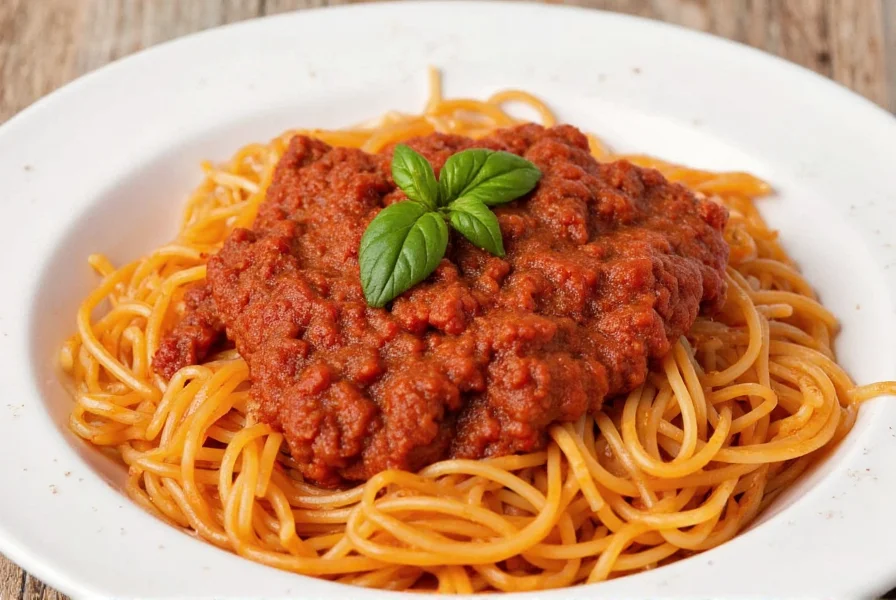The essential seasonings for spaghetti meat include salt, black pepper, garlic, onion, dried oregano, dried basil, and red pepper flakes. For authentic Italian flavor, add 1 teaspoon salt, ½ teaspoon black pepper, 2 minced garlic cloves, 1 diced onion, 1 teaspoon dried oregano, 1 teaspoon dried basil, and a pinch of red pepper flakes per pound of ground beef. Always season in layers—add some spices early when browning meat and others during simmering for balanced flavor development.
Creating the perfect spaghetti meat sauce starts with proper seasoning. Many home cooks make the mistake of under-seasoning their meat or adding all spices at once, resulting in flat, one-dimensional flavor. The right combination of herbs and spices transforms simple ground beef into a rich, aromatic foundation for your pasta dish. This guide reveals professional techniques for seasoning spaghetti meat that elevate your sauce from ordinary to extraordinary.
Essential Seasonings for Spaghetti Meat
When asking what to season spaghetti meat with, start with these foundational ingredients that create authentic Italian flavor:
- Salt - Enhances all other flavors and draws out meat's natural juices
- Freshly ground black pepper - Adds subtle heat and complexity
- Fresh garlic - Provides aromatic depth (2-3 cloves per pound of meat)
- Yellow onion - Creates sweet foundation when properly caramelized
- Dried oregano - Classic Italian herb with earthy notes
- Dried basil - Complements tomatoes and adds herbal brightness
- Red pepper flakes - Optional for subtle heat (¼-½ teaspoon per pound)
For the best herbs for spaghetti meat sauce, dried oregano and basil outperform fresh versions in meat sauces because their concentrated flavor withstands long cooking times. Add dried herbs early in the cooking process to allow their flavors to fully develop.
| Seasoning | Amount per Pound of Meat | When to Add |
|---|---|---|
| Salt | 1 teaspoon | Half when browning, half during simmering |
| Black pepper | ½ teaspoon | Half when browning, half during simmering |
| Garlic | 2-3 cloves, minced | After meat is browned |
| Dried oregano | 1 teaspoon | When adding tomatoes |
| Dried basil | 1 teaspoon | When adding tomatoes |
| Red pepper flakes | ¼-½ teaspoon | With garlic |
Timing Matters: When to Add Spices to Spaghetti Meat
Understanding when to add spices to spaghetti meat makes a significant difference in flavor development. Many home cooks make the critical error of adding all seasonings at once, which prevents proper flavor layering.
For optimal results with your spaghetti meat seasoning blend:
- Initial browning: Add half your salt and pepper to the raw meat before browning. This helps draw out moisture for better searing.
- After browning: Add garlic, red pepper flakes, and onion to the fond (browned bits) in the pan. This builds flavor foundations.
- With tomatoes: Add dried herbs like oregano and basil when incorporating tomato products. The acidity helps release their essential oils.
- During simmering: Add remaining salt and pepper halfway through cooking to prevent over-concentration.
- Before serving: Stir in fresh basil or parsley for bright finish (optional).

Regional Italian Variations
Authentic Italian cooking features regional differences in traditional Italian spaghetti meat seasoning. Understanding these variations helps create more authentic flavors:
- Northern Italy: Features more butter and less tomato; often includes nutmeg with meat
- Central Italy: Balanced approach with equal parts herbs and tomatoes
- Southern Italy: Bolder flavors with more garlic, oregano, and red pepper
For authentic Italian meat sauce seasonings, consider your desired flavor profile. Northern-style sauces work well with delicate pasta shapes, while robust southern-style seasonings stand up to hearty spaghetti.
Avoiding Common Seasoning Mistakes
Many home cooks make these critical errors when determining what spices go well with spaghetti meat:
- Under-seasoning: Meat needs more salt than you think—remember you're seasoning for the entire dish
- Adding all spices at once: Prevents proper flavor development and can make herbs taste bitter
- Using old spices: Dried herbs lose potency after 6 months—replace regularly
- Overlooking acid balance: A splash of red wine or balsamic vinegar brightens heavy meat flavors
- Not tasting as you go: Adjust seasoning throughout cooking process
When creating your homemade spaghetti meat seasoning blend, remember that seasoning isn't just about adding ingredients—it's about building flavors incrementally.
Adjusting for Dietary Needs
For those with special dietary requirements, here's how to adapt your seasoning ratio for spaghetti meat sauce:
- Salt-free diets: Replace salt with 1 teaspoon lemon zest + ½ teaspoon celery seed per pound of meat
- Low-sodium options: Use ½ teaspoon salt plus 1 teaspoon nutritional yeast for umami
- Gluten-free concerns: Ensure all dried herbs are pure (some blends contain gluten)
- Enhanced umami: Add 1 teaspoon tomato paste when browning meat for deeper flavor

Creating Your Signature Blend
Once you've mastered the basics of how to season ground beef for spaghetti, experiment with these professional enhancements:
- Add 1 teaspoon fennel seeds when browning meat for sausage-like depth
- Include 1 bay leaf during simmering (remove before serving)
- Stir in 2 tablespoons red wine when deglazing the pan
- Finish with 1 teaspoon fresh lemon juice to brighten flavors
- For meatballs in sauce, add ¼ cup grated Parmesan to the meat mixture
The key to exceptional spaghetti meat lies in balancing the five fundamental tastes: salty, sweet, sour, bitter, and umami. Proper seasoning creates harmony between these elements, resulting in a sauce that tastes complex yet perfectly balanced.
Frequently Asked Questions
Can I use fresh herbs instead of dried for spaghetti meat?
You can use fresh herbs, but you'll need three times the amount of dried herbs called for in most recipes. Add fresh herbs like basil and oregano during the last 10-15 minutes of cooking to preserve their delicate flavor. Dried herbs work better for long-simmering meat sauces as their flavor concentrates during cooking.
How much seasoning should I use for 2 pounds of spaghetti meat?
For 2 pounds of ground beef, use 2 teaspoons salt, 1 teaspoon black pepper, 4-6 minced garlic cloves, 1 diced onion, 2 teaspoons dried oregano, 2 teaspoons dried basil, and ½ teaspoon red pepper flakes. Remember to add half the salt and pepper when browning the meat and the rest during simmering for balanced flavor.
Why does my spaghetti meat taste bland even with seasoning?
Bland spaghetti meat usually results from adding all seasoning at once or not allowing enough simmering time. Proper technique involves seasoning in layers—add some spices when browning meat, others with the tomatoes, and final adjustments during cooking. Also ensure you're using quality ingredients; stale spices or lean meat with little fat won't carry flavors well.
Should I season the meat before or after browning for spaghetti sauce?
Season the meat with half the salt and pepper before browning to help draw out moisture for better searing. Add garlic, dried herbs, and other seasonings after the meat is browned, when you're building the sauce foundation. This two-stage seasoning approach creates more complex flavors than adding everything at once.
What's the secret ingredient for flavorful spaghetti meat?
The secret to exceptional spaghetti meat is proper layering of flavors and patience. Start by properly browning the meat (don't overcrowd the pan), then build flavor with the "holy trinity" of Italian cooking: garlic, onion, and celery. Add dried herbs when incorporating tomatoes, and finish with a splash of red wine or balsamic vinegar to brighten the rich meat flavors. Most importantly, allow at least 30 minutes of simmering time for flavors to meld.











 浙公网安备
33010002000092号
浙公网安备
33010002000092号 浙B2-20120091-4
浙B2-20120091-4